How To Set Up An Iv Bag
Affiliate 8. Intravenous Therapy
8.7 Priming Iv Tubing / Changing Four Bags / Irresolute IV Tubing
Main and secondary IV tubing and add-on devices (extension tubing) must be primed with Iv solution to remove air from the tubing. Priming refers to placing Four fluid in IV tubing to remove all air prior to attaching the 4 tube to the patient. Iv tubing is primed to prevent air from inbound the circulatory system. An air embolism is a potential complication of IV therapy and can enter a patient's claret organisation through cut tubing, unprimed IV tubing, admission ports, and baste chambers with too footling fluid (Perry et al., 2022). It is unknown how much air volition cause death, simply deaths have been reported with as piffling every bit x ml of air. The best way to avoid air bubbles in IV tubing is to forbid them in the offset place (Perry et al., 2022). New Iv tubing may also be required if leaking occurs around the tube connecting to the Four solution, if the tubing becomes damaged, or if it becomes contaminated. Checklist 66 outlines the procedure of priming Four tubing.
Checklist 66: Priming IV TubingDisclaimer: Ever review and follow your agency policy regarding this specific skill. | ||||
Safety considerations:
| ||||
Steps | Boosted Data | |||
| one. Perform hand hygiene. | This step prevents the transmission of microorganisms. | |||
| 2. Cheque order to verify solution, rate, and frequency. | This ensures 4 solution is correct and helps prevent medication error. | |||
| iii. Gather supplies. | You will need 4 solution, primary Iv tubing, the labels for tubing and the handbag, alcohol swab, and basin or sink. | |||
| 4. Remove Iv solution from outer packaging and gently clasp. Check death engagement. Assess for precipitates or cloudiness. Hang 4 bag on claw or IV pole in a way that will permit gravity to help you to prime the line. | You need to verify integrity of the solution. Annotation the death engagement on IV bags are reported by month and year. The product is valid for the entire month. | |||
| 5. Remove chief Four tubing from outer packaging. Remover newspaper. | 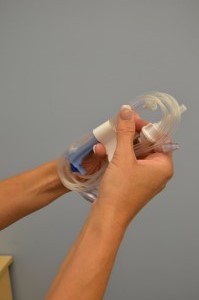 | |||
| 6. Movement the roller clamp to about 3 cm below the drip bedchamber and close the clamp. | 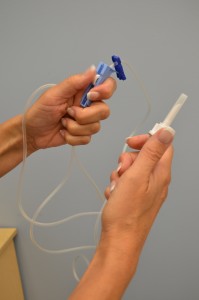 | |||
| seven. Remove the protective cover on the Iv solution port and go on sterile. Remove the protective comprehend on the IV tubing spike. Follow principles of asepsis. | 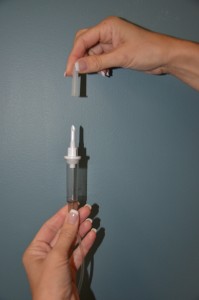 Practise non contaminate the spike. | |||
| 8. Remove the protective encompass from the Four solution port. Without contaminating the solution port or spike, carefully insert the Iv tubing fasten into the port, gently pushing and twisting. | 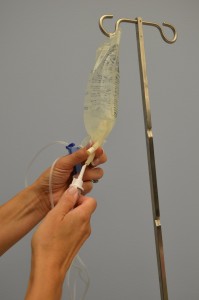 | |||
| 9. Fill the drip chamber one-third to one-one-half full by gently squeezing the chamber. Only if admittedly necessary, remove protective embrace on the distal end of the tubing and keep sterile. | Filling the drip chamber prevents air from entering the IV tubing. 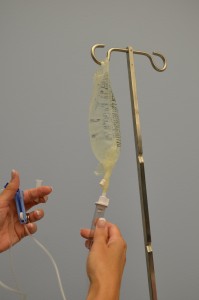 Not removing the protective comprehend on the distal stop of the tubing helps to maintain asepsis. | |||
| ten. With distal cease of tubing over a basin / sink / garbage, slowly open roller clamp to prime number the 4 tubing. Invert back check valve and ports every bit the fluid passes through the tubing. Tap gently to remove air and to fill with fluid. | Inverting and borer the dorsum check valve and access ports helps displace and remove air when priming the 4 tubing. | |||
| 11. In one case Four tubing is primed, cheque the entire length of tubing to ensure no air bubbles are present. | This step confirms that air is out of the IV tubing. | |||
| 12. Close roller clamp. If removed earlier, embrace distal end with sterile expressionless-ender or sterile protective cover. Hang tubing on Iv pole to prevent from touching the ground. | Keep the distal cease sterile prior to connecting IV to patient. | |||
| 13. Label tubing and Four pocketbook with engagement, time, and initials. | Label Iv solution bag equally per agency policy. Do not write directly on the IV pocketbook. | |||
| 14. Perform hand hygiene. | This reduces the transmission of microorganisms. | |||
| Data sources: Fulcher & Frazier, 2007; Perry et al., 2022. | ||||
Scout the videoPriming IV Lines developed by Renée Anderson and Wendy McKenzie TRU School of Nursing (2018).
IV solutions are considered sterile for 24 hours. An 4 solution may be changed if the doctor's order changes, if an IV solution has been running slowly and has been hanging for 24 hours, or if the IV solution becomes contaminated. To alter an IV solution bag, follow Checklist 67.
Checklist 67: Changing an Iv BagDisclaimer: E'er review and follow your bureau policy regarding this specific skill. | ||||
Steps | Additional Information | |||
| i. Verify and select correct IV solution bag, and compare to the medication administration record (MAR) or prescriber's orders. | Iv solutions are considered a medication and must be checked using the SEVEN rights and THREE checks, every bit per agency policy. 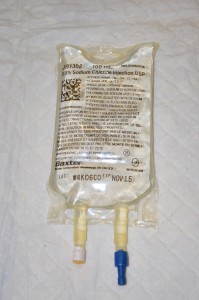 | |||
| 2. Introduce yourself, identify patient, and explain procedure. | Proper identification of a patient prevents medication errors. Explaining the process provides an opportunity for the patient to inquire questions. | |||
| iii. Perform paw hygiene. | Mitt hygiene prevents the manual of microorganisms. | |||
| four. Remove IV solution from outer packaging and gently clasp. Bank check expiration engagement. Appraise for precipitates or cloudiness. Hang new Four solution on 4 pole. | 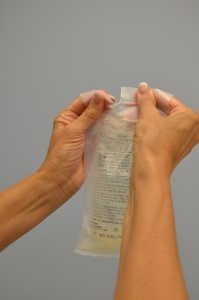 Expiry dates on IV bags are reported by month and year. The production is valid for the entire calendar month. | |||
| 5. If infusing the Iv by EID, interruption the device. If infusing the Iv via gravity, close the roller clamp on the infusion set. | Stops the infusion to forbid air bubbles from forming in Iv tubing. | |||
| 6. Remove the protective cover from the IV solution (new purse) port. | Keep all ports sterile. | |||
| 7. Remove the old IV solution bag from the IV pole. Turn old Iv bag upside down, grasping the bag with the not-dominant mitt and the spike with the dominant hand. With a twisting motion, carefully remove Iv tubing spike from sometime Four solution bag. | Removing old solution from IV pole and inverting information technology prevents spilling of solution. Ensure Four tubing fasten remains sterile during removal to avoid contaminating IV tubing. | |||
| 8. Using a gentle dorsum and forth twisting motion, firmly insert the spike into the new IV bag. | This ensures that principles of asepsis are followed. | |||
| 9. If necessary, fill the baste chamber by compressing it between your thumb and forefinger. Ensure the drip chamber is one-tertiary to one-half full. Check Iv tubing for air bubbling. | Fluid in the drip bedroom helps prevent air from beingness introduced into Iv tubing. | |||
| ten. If using gravity: Open up clench and regulate 4 infusion rate with the roller clench. If using EID: Ostend rate and volume to be infused, press start to resume the infusion. | If using gravity, count the drops per infinitesimal in the drip chamber If using an EID follow the prompts on the screen to ensure the 4 is running at the correct charge per unit. | |||
| 11. Label new IV solution bag as per agency policy. | Labelling IV solutions provides easy viewing of infusing solutions, additives and when the bag was hung.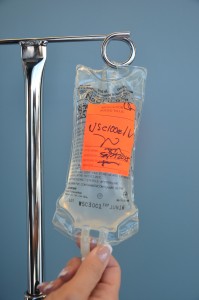 | |||
| 12. Dispose of used supplies, perform hand hygiene, and certificate 4 solution pocketbook alter co-ordinate to agency policy. | Document time, date, type of solution, rate, and total volume. | |||
| Information sources: Fulcher & Frazier, 2007; Perry et al., 2022. | ||||
Watch the video Irresolute 4 bagsdeveloped by Renée Anderson and Wendy McKenzie TRU Schoolhouse of Nursing (2018)
Checklist 68 describes how to modify the IV assistants fix and 4 solution at the same fourth dimension.
Checklist 68: Irresolute 4 TubingDisclaimer: Always review and follow your agency policy regarding this specific skill. | ||||
Steps | Additional Data | |||
| one. Verify prescriber's orders for the blazon of solution, rate, and duration. Collect necessary supplies. | This step verifies the patient's need for Four fluids or medications. Information technology also confirms the correct rate and solution for patient safety. | |||
| 2. Perform mitt hygiene. | Paw hygiene prevents the transmission of microorganisms. | |||
| 3. Place yourself, identify the patient using two identifiers, and explain the procedure to the patient. | Proper identification of patient prevents errors.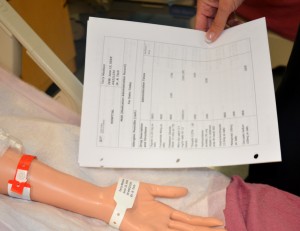 | |||
| four. Prime new administration fix using a new IV solution bag and new IV tubing. Label Four solution and IV tubing as per agency policy. If necessary, add an extension set up including a needleless cap. | Four solutions are considered a medication. Prime as per Checklist 66. If possible, go on distal protective cap fastened to 4 tubing to ensure sterility of distal finish. Labelling ensures advice between staff. Extension sets assistance to reduce micromovements at the cannula insertion site and protect from BBF exposure during IV tubing changes. Note: Some CVADs have extension tubing equally a permanent part of their construction. | |||
| 5. Hang new assistants ready (primed primary line and Iv solution) on IV pole. | This prepares the equipment and adheres to the principles of hygienic technique. | |||
| 6. Terminate the infusion. If using an EID, remove Iv tubing from the device. | Stop the flow of infusion during tubing and solution change. | |||
| vii. Perform point of care risk assessment; donne non-sterile gloves. Make clean the connectedness between the distal end of old Four tubing and the needleless cap. Scrub the area for 15 to thirty seconds using friction, and let information technology dry. | Proper disinfection of equipment decreases bacterial load and prevents infections. 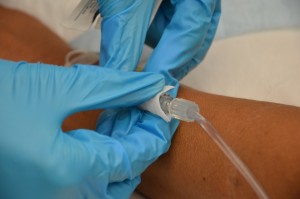 | |||
| 8. Remove the protective cap on the distal end of the new Four administration set. | 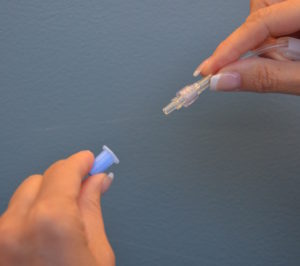 | |||
| nine. If the extension is nowadays and you are Non changing it, leave extension and needleless cap in place. If the extension isn't nowadays and/or yous are changing the extension set, loosen the IV tubing from the IV cannula.
| Understanding the structure and office of unlike Four access devices helps to determine risk of air emboli / exposure to BBF and subsequent safety considerations and need for clamping. PVAD-short: Occluding vein reduces risk of BBF exposure. CVAD – open ended: Clamps reduce risk of air emboli and/or BBF exposure. | |||
| 10. Carefully disconnect the old tubing and Luer lock the new IV tubing into the cap. | 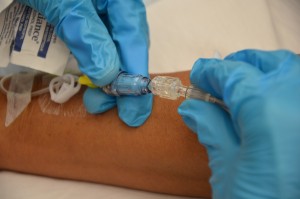 Luer locks reduce take chances of air emboli and provide security for keeping Four lines and connections intact. Maintain principles of asepsis. | |||
| 11. If using gravity: Open clamp and regulate IV infusion rate. If using EID: Confirm rate and volume to be infused, press start to resume the infusion. | This stride ensures the 4 solution is infusing at the correct charge per unit.  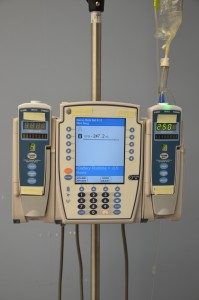 | |||
| 12. Check 4 site for patency and prove of complications. | 4 site should be free from redness, swelling, pain and leaking. Transparent semipermeable dressing on IV site should be dry and intact. | |||
| 13. Discard one-time supplies and perform hand hygiene. | This footstep prevents the spread of microorganisms. | |||
| xiv. Document process as per bureau policy. | Document the appointment and fourth dimension of 4 tubing and solution change. | |||
| Data sources: BCIT, 2015b; Fulcher & Frazier, 2007; Perry et al., 2022 | ||||
Disquisitional Thinking Exercises
- What is the purpose of removing air from Four tubing?
- Yous come on shift and discover the patient'south Iv tubing is not labeled. Describe your side by side actions.
Source: https://pressbooks.bccampus.ca/clinicalproceduresforsaferpatientcaretrubscn/chapter/8-7-priming-iv-tubing-changing-iv-bags-changing-iv-tubing/

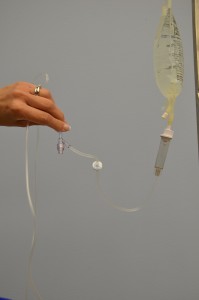
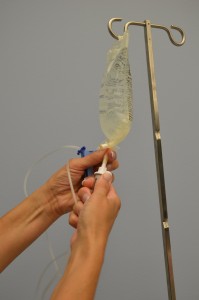

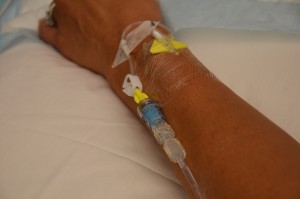
0 Response to "How To Set Up An Iv Bag"
Post a Comment